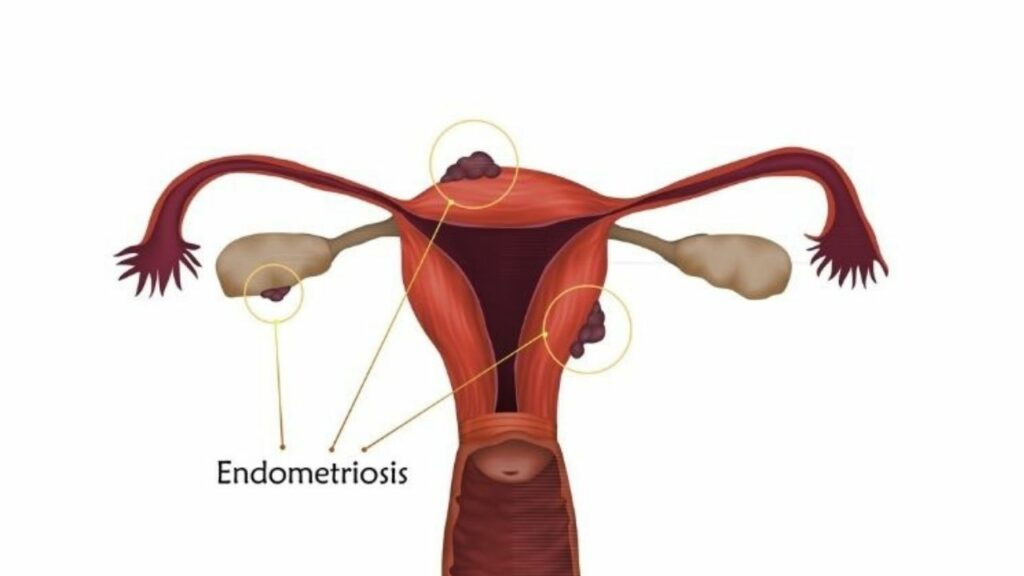Endometriosis is a chronic gynaecological condition that affects millions of women worldwide. It is characterized by the growth of endometrial tissue outside the uterus, leading to pain, inflammation, and, in many cases, infertility. Despite being relatively common, endometriosis is often diagnosed late due to a lack of awareness and understanding of the disease. This article explores endometriosis, its symptoms, and how pelvic floor exercises provided by a Women’s Health Physio can be a key tool in the treatment and management of this condition.
What is Endometriosis?
Endometriosis occurs when tissue similar to the lining of the uterus (endometrium) grows in areas where it should not, such as the ovaries, fallopian tubes, the outer surface of the uterus, intestines, bladder, and, in some cases, even more distant areas like the lungs. This tissue continues to respond to the menstrual cycle, thickening, breaking down, and bleeding just as the endometrium inside the uterus would. However, being out of place, it has no way to exit the body, leading to the formation of scar tissue, adhesions, and cysts.

What are the Symptoms of Endometriosis? How to Diagnose Endometriosis?
The symptoms of endometriosis vary, but the most common is pelvic pain, which can be debilitating. Other manifestations include:
– Pain during or after sexual intercourse.
– Pain during menstruation (dysmenorrhea) or at other times of the menstrual cycle.
– Pain during bowel movements or urination, especially during menstruation.
– Infertility.
– Fatigue, diarrhea, constipation, bloating, and nausea, particularly during menstrual periods.
Diagnosing endometriosis can be challenging, as the symptoms are similar to those of other pelvic conditions. It is generally confirmed through laparoscopic surgery, in which endometrial implants are visualized and biopsied.
What are the Treatment for Endometriosis?
Treatment for endometriosis may include medications to relieve pain and reduce inflammation, hormonal treatments to reduce or eliminate menstruation, and, in severe cases, surgery to remove endometrial lesions. However, many patients find that these treatments are not entirely effective or come with significant side effects.
This is where pelvic floor exercises become an effective adjunct intervention. Women’s Health Physio do not directly treat the underlying cause of endometriosis, but they can help alleviate many of its debilitating symptoms, thereby improving patients’ quality of life.
How Women’s Health Physio treat Endometriosis?
Women’s Health Physio treatment focuses on the assessment and treatment of the pelvic floor muscles, a network of muscles that support the bladder, uterus, and intestines, and are involved in functions such as urination, defecation, and sexual activity. In patients with endometriosis, chronic pain and inflammation can lead to dysfunctions in these muscles, such as tension, spasms, and weakness.

Benefits of a Women’s Health Physio treatment for Endometriosis
1. Relief of Pelvic Pain: One of the primary goals of physical therapy in managing endometriosis is to reduce pelvic pain. Manual therapy techniques, such as soft tissue mobilization and myofascial release, can help release tension and adhesions in the pelvic floor muscles and tissues, relieving pain.
2. Improvement of Muscle Function: Pelvic floor rehabilitation exercises can strengthen weakened muscles and reduce tension in those that are overly contracted. This can improve bladder and bowel control and reduce dyspareunia (pain during sexual intercourse).
3. Education and Counseling: Education is an integral part of physical therapy. A specialized therapist can teach patients about pelvic floor anatomy, pain management, and how to perform relaxation and strengthening exercises at home. They can also offer advice on posture, breathing techniques, and stress management, which can be useful in controlling endometriosis symptoms.
4. Relaxation Techniques and Stress Management: Endometriosis is a condition often associated with high levels of stress, which can exacerbate pain and other symptoms. Pelvic floor therapists can incorporate relaxation techniques, such as diaphragmatic breathing and biofeedback, to help patients manage stress and reduce muscle tension.
5. Improvement of Sexual Quality of Life: Dyspareunia is a common symptom of endometriosis. Pelvic floor physical therapy can include techniques to improve tissue elasticity and reduce pain during sexual activity, which can have a significant impact on the patient’s quality of life and emotional well-being.
Specific Treatments for Endometriosis delivered by Women’s Health Physio
Physiotherapy treatments for endometriosis can include a variety of approaches tailored to the patient’s needs:
1. Manual Therapy: Manual therapy is used to mobilize and release pelvic structures, including muscles, ligaments, and fascial tissue. This helps reduce stiffness and adhesions that develop due to chronic inflammation.
2. Pelvic Floor Rehabilitation Exercises: These exercises focus on improving the strength, flexibility, and coordination of the pelvic floor muscles. Exercises such as Kegels can be helpful, though they should be adapted by a physical therapist to avoid overuse, which may increase pain.
3. Scar Mobilization: After surgery for endometriosis, scar tissue may form that affects pelvic floor function. Physical therapy can help mobilize these scars to improve tissue mobility and reduce pain.
4. Biofeedback: Biofeedback is a technique that helps patients become aware of their pelvic floor muscle function through the use of sensors that monitor muscle activity. This allows the patient to learn to relax or activate the muscles as needed.
5. Electrostimulation: In some cases, electrostimulation may be used to improve muscle function, reduce pain, and promote healing in the pelvic floor tissues.
6. Stretching and Mobility Therapy: Specific stretches and mobility exercises can alleviate muscle tension and improve overall flexibility, which can contribute to a reduction in pelvic pain.

Endometriosis in Summary
Endometriosis is a complex disease that requires a comprehensive and multidisciplinary treatment approach. Pelvic floor physiotherapy is a valuable intervention that can help women with endometriosis manage their symptoms, improve their quality of life, and regain lost functionality. It is essential for patients to work with a specialized physical therapist who can develop a personalized treatment plan that addresses their specific needs. While it is not a cure for endometriosis, pelvic floor physiotherapy offers a significant opportunity to relieve pain and improve overall well-being, becoming a vital part of the therapeutic approach to this condition.



